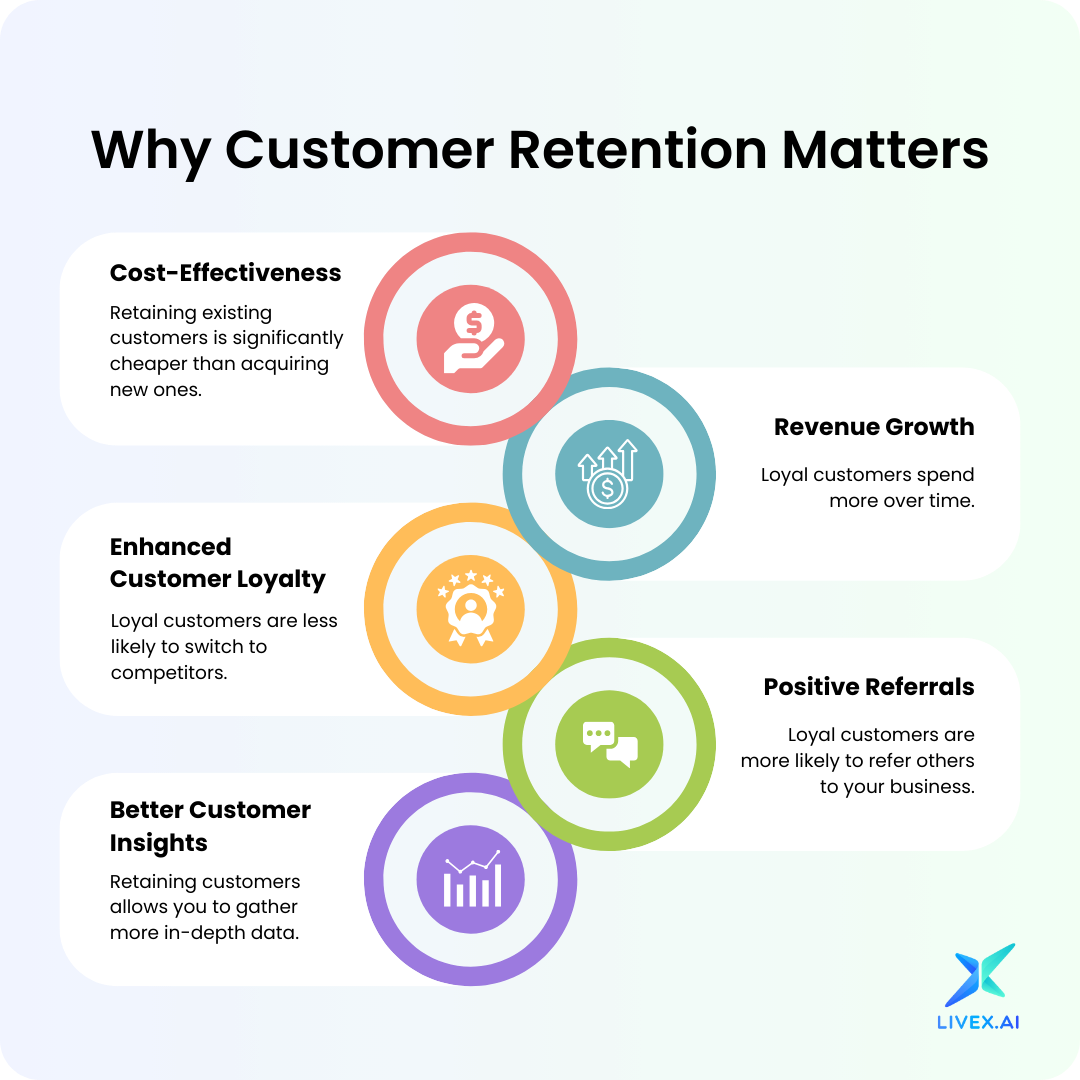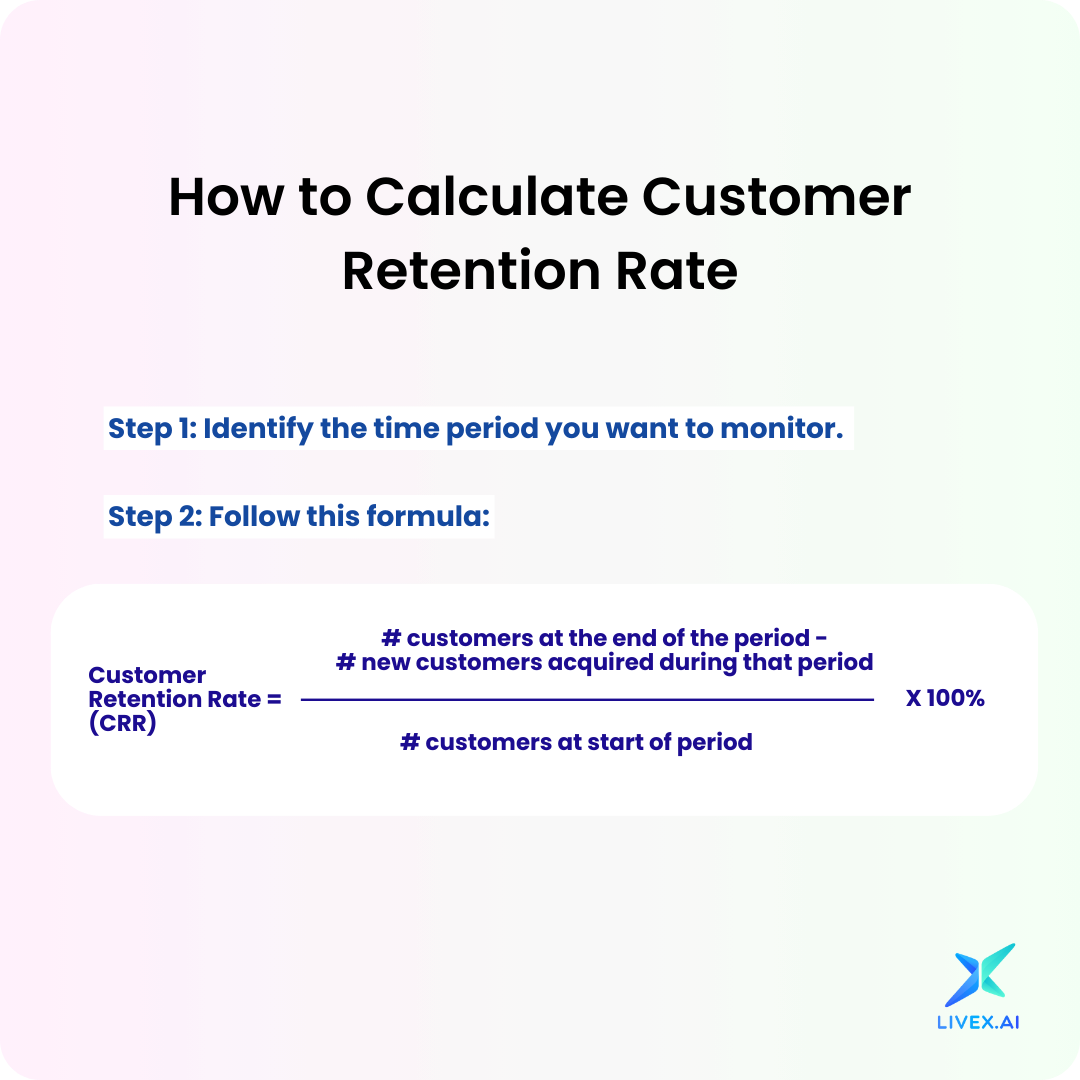In today’s highly competitive market, focusing on customer retention is not just an option—it’s a necessity. While acquiring new customers is important, retaining existing ones is often more cost-effective and beneficial in the long run. High retention rates contribute significantly to revenue growth, brand loyalty, and overall business success. In this detailed guide, we will explore why customer retention matters, how to improve it, and how advanced AI tools can help manage and reduce churn.
Why Customer Retention Matters
- Cost-Effectiveness: Retaining existing customers is significantly cheaper than acquiring new ones. Studies suggest that acquiring a new customer is 5 to 25 times more expensive than retaining existing one. This cost disparity highlights the importance of investing in retention strategies to enhance your bottom line.
- Revenue Growth: Loyal customers spend more over time. Research indicates that a 5% increase in customer retention can boost revenue by 25% to 95%. Existing customers are likelier to make repeat purchases, explore additional products, and become brand advocates.
- Enhanced Customer Loyalty: Consistently meeting or exceeding customer expectations builds trust and loyalty. Loyal customers are less likely to switch to competitors, leading to a more stable revenue stream and reduced customer acquisition costs.
- Positive Referrals: Loyal customers are likelier to refer others to your business. Positive word-of-mouth is a powerful marketing tool that can attract new customers without additional advertising costs.
- Better Customer Insights: Retaining customers over time allows you to gather more in-depth data on their preferences, behaviors, and feedback. This wealth of information can be used to tailor your products, services, and marketing strategies to meet their needs better, leading to even higher retention rates.

Calculating Customer Retention Rate
Understanding and tracking your Customer Retention Rate (CRR) is crucial for evaluating the effectiveness of your retention strategies. The first step is to identify the period you want to monitor. Next, you can use the following formula:
Customer Retention Rate (%) = (Number of customers at the end of the period - Number of new customers acquired during that period) / (Number of customers at the start of the period) * 100

This graphic is adapted from HubSpot’s article 'Here’s Why Customer Retention is So Important for ROI, Customer Loyalty, and Growth.'
Example Calculation:
- Starting Customers: 100
- New Customers Acquired: 20
- Ending Customers: 90
Customer Retention Rate (%) = (90-20)/100*100 = 70
A high retention rate indicates that your strategies are effective, while a lower rate may suggest improvements.
Average Customer Retention Rate by Industry
Now that you’ve calculated your CRR, it’s crucial to compare it to the average retention rates in your industry. This benchmark will help you understand where you stand relative to your competitors and identify areas for improvement. According to CustomerGauge’s 2024 roundup of industry retention rates, the average retention rates by industry are as follows:
- Energy/Utilities: 89%
- IT Services: 88%
- Computer Software: 86%
- Industry Services: 83%
- Financial Services: 81%
- Telecommunications: 69%
- Manufacturing: 65%
- Logistics: 60%
- Consumer Packaged Goods: 60%
- Wholesale: 44%
If your CRR falls below your industry's average, it might signal that your retention strategies need a revamp. On the other hand, if your CRR is above the average, you’re on the right track but still need to refine your approach to maintain and improve it continuously.
Effective Strategies for Improving Customer Retention
- Set Clear Expectations: Clearly define and communicate what customers can expect from your product or service. For example, if you run a software-as-a-service (SaaS) company and a customer signs up for your premium plan with an interest in an upcoming feature (e.g., a new integration with a popular third-party tool), it’s essential to provide a realistic timeline for that feature’s release and follow through.
- Regular Communication: Beyond setting expectations, keep customers actively informed about their ongoing experience and the value they’re receiving. Provide regular updates on performance metrics, product improvements, and key milestones through dashboards, email reports, or newsletters.
- Build Personal Connections: Foster strong relationships by understanding your customers' needs and preferences. Personalize interactions and recognize significant milestones or achievements. For instance, celebrate anniversaries or achievements with personalized messages or offers.
- Act on Customer Feedback: Regularly gather feedback through surveys, reviews, and direct conversations. Use this valuable feedback to identify areas for improvement and address concerns proactively..
- Ensure Consistent Experiences: Deliver a consistent experience across all customer touchpoints. This includes consistent communication, service quality, and support. To maintain consistency, develop standardized processes for onboarding, support, and service delivery.
- Empower Customers with Resources: Provide customers with tools and resources to help them succeed independently. This includes tutorials, knowledge bases, and self-service options. This reduces their dependency on support and enhances their overall experience.
- Implement a Customer Loyalty Program: Reward loyal customers with incentives such as discounts, exclusive offers, or points. A well-designed loyalty program can increase customer retention by providing additional value and encouraging repeat business.
Addressing Churn with Advanced AI Solutions
Even with robust retention strategies, some customers may still consider leaving. Advanced Gen AI solutions like LiveX AI’s ChurnControl are designed to address these situations effectively.
How LiveX AI ChurnControl Works:
- Proactive Customer Insights: Leverages AI to preemptively understand and address customer needs, resolving issues before dissatisfaction arises.
- Empathetic Engagement: Engages customers with empathetic communication using advanced natural language processing and optional avatars.
- Data-Driven Churn Reduction: Continuously analyzes interaction data to uncover patterns and insights, refining strategies to reduce churn.
- Enhanced Customer Loyalty: Strengthens customer relationships, transforming users into loyal advocates and increasing their lifetime value.
Conclusion
Customer retention is a key driver of long-term business success. Effective retention strategies are more cost-efficient than customer acquisition, leading to increased revenue and brand loyalty. To reduce churn and strengthen customer relationships, make sure to regularly evaluate retention metrics, engage customers proactively, and utilize AI-driven solutions like LiveX AI’s ChurnControl.
LiveX AI is committed to driving innovation in this space and helping businesses deliver exceptional customer experience..
FAQs
- What are early signs of customer churn?
Early signs of churn include reduced engagement, negative feedback, increased support requests, low NPS scores, and changes in purchasing behavior. Monitor these indicators to address customer churn proactively. - Can customer retention strategies differ for B2B and B2C businesses?
Yes, B2B retention often focuses on building long-term relationships and offering personalized support, while B2C may emphasize loyalty programs, consistent communication, and fast customer service. - How do AI tools like LiveX AI ChurnControl enhance retention efforts?
AI tools analyze customer data to predict churn risks, personalize communication, and suggest retention actions. This allows businesses to be more proactive, human-like, and targeted in their retention efforts without accelerating costs. - How often should I review and adjust my retention strategies?
It’s advisable to review retention strategies quarterly to ensure they align with changing customer needs, market conditions, and business goals. - What is the role of customer onboarding in retention?
A strong onboarding process can set the tone for a customer's experience with your brand. Ensuring customers understand how to use your product and its benefits reduces early churn and boosts long-term retention. - What are the most common mistakes businesses make in retention efforts?
Common mistakes include a lack of personalized communication, failing to act on customer feedback, and focusing solely on acquiring new customers rather than nurturing existing ones. - How can I measure the ROI of my retention strategies?
Measure ROI by comparing the cost of retention initiatives against the revenue generated from retained customers over time. Consider factors like reduced churn rate, increased customer lifetime value, and enhanced brand loyalty.
